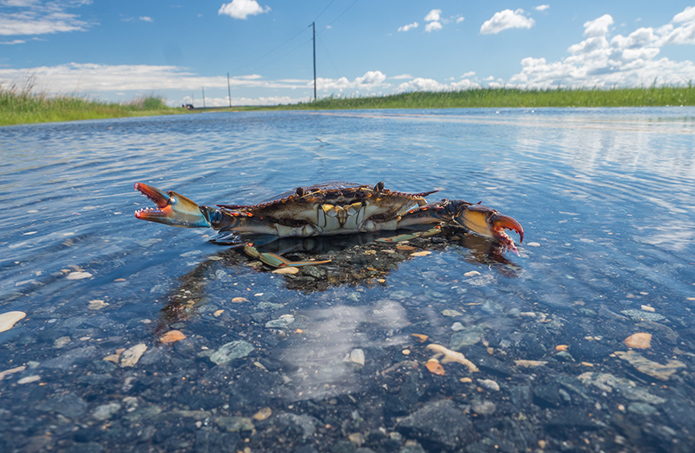By Karl Blankenship
Bay Journal
A new report warns that Maryland will face a dramatic increase in the rate of sea level rise later this century, with nuisance flooding becoming a daily occurrence in many waterfront areas if nations fail to curb greenhouse gas emissions.
If emissions continue to rise, sea level in Maryland would likely increase 2.0 to 4.2 feet by 2100, which is two to four times the rate seen during the last century, according to the report from the University of Maryland Center for Environmental Science that was released in December. There is an outside chance the rise could exceed 5.2 feet, the report said.
If countries meet commitments in the 2015 Paris Climate Agreement, the sea level would still rise, but at a slower rate, with the likely increase ranging from 1.2 to 3.0 feet, with a 1-in-20 chance that the increase could exceed 3.7 feet.
“It actually has some good news and bad news,” said Donald Boesch, lead author of the report and former UMCES president. “The bad news is that there’s more evidence that unless we really limit warming to the Paris Agreement level… sea level rise could be higher than we thought. The good news is that if we’re on the emissions pathway that gets us to the Paris Agreement, it’s much more manageable.”
In any scenario, places along tidal waterways will become wetter. Nuisance flooding that occurred just a few times a year in places like the Annapolis city dock during the 1950s now takes place 40 or more days per year. Even under the best-case scenarios, according to the report, flooding there and in Baltimore’s Inner Harbor would become a near-daily occurrence. Meanwhile, storm surges during hurricanes would become much more dangerous.
The report, which is updated every five years, represents the consensus of an expert group of climate scientists from the mid-Atlantic region. It differs from the 2013 report by including alternative future scenarios based on whether nations successfully limit temperature increases to 2 degrees Celsius, as called for in the Paris agreement.
Through 2050, the report said, the most likely range of sea level rise in Maryland would be 0.8 to 1.6 feet (measured from a 2000 baseline), though there is a 5% chance of it exceeding 2 feet.
The extent to which emissions are reduced would begin to have a more pronounced impact in the second half of the century and become even greater after 2100, driven mostly by the loss of polar region ice, especially in Antarctica.
If no further actions are taken to curb global emissions through the end of this century, sea level rise in Maryland by 2150 would range from 3.4 to 6.6 feet, with a 1-in-20 chance it could exceed 8.5 feet.
If the Paris Agreement goals are met, the likely range of increase would be kept to 1.8 to 4.2 feet.
A major uncertainty is whether warmer temperatures could lead to the destabilization and more rapid loss of major ice sheets, in which case the amount of sea level rise in the state could be even greater, exceeding 20 feet in the next century, the report said. “Back at the beginning of the 20th century, more than 100 years ago, Greenland and Antarctica, were fairly stable,” Boesch said. “They were actually building ice. And now the evidence is pretty clear they’re losing ice. That process is just likely to accelerate, like literally a meltdown. How fast that meltdown will be depends on how much more warming there is.”




GMAB! You environmental whackos simply won’t quit. Regardless, please know that the only ones who are foolish enough to buy into the “end-of-the-world” nonsense the bunch of you have been spitting out for the past 30 or 40 years are the totally indoctrinated––the fully brainwashed.
But you’re clever, I’ll give you that. In the early days of this “algore-scare” baloney we were told that in 50-100 years or so the seas will rise and drown us all. But you soon caught on that most people said that’s too far away to worry about so they ignored you. So then you started saying, oh wait, it’s all going to happen in 10-15 years! This got their attention, alright, but then when the 10-15 years arrived, and absolutely nothing has changed (except the media’s lying and exaggerations) you had a different problem to deal with. Credibility even with your idiotic believers.
So, knowing that the “long term” threat doesn’t work, and the short term threat is regularly revealed as a hoax, what you now do is speak to future, “natural” occurrences and paint them as all AGW related. Hurricanes, tornadoes, forest fires have all been identified as the “consequences” of global warming. As soon as a serious natural disaster strikes (which are guaranteed to statistically occur), you’ve got your phony-baloney copy at the ready.
But now I see you’ve got a new bogeyman: local flooding! So every time a local flood creates havoc in an area, the brainwashed will tell each other that it’s global warming! Whereas in the past people understood that 100 and 150 year storms invariably happen and predictably cause flooding (especially where properties were foolishly developed in those floodplains) now you’ve got the idiots thinking global warming.
Fortunately I moved far from Maryland few years ago and have never been more pleased with any other decision I’ve ever made. Not that the environmental whackos aren’t everywhere, but there seems to be fewer of them where I am at the moment. Hopefully it’ll stay like that for a while.